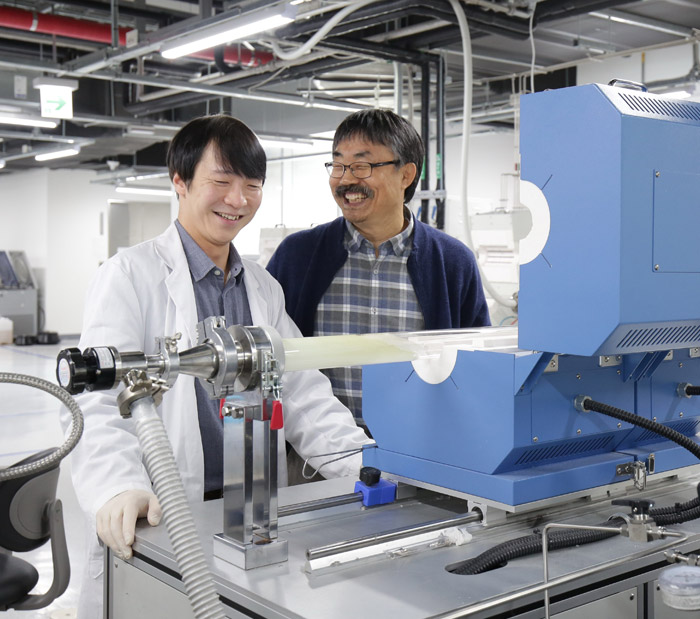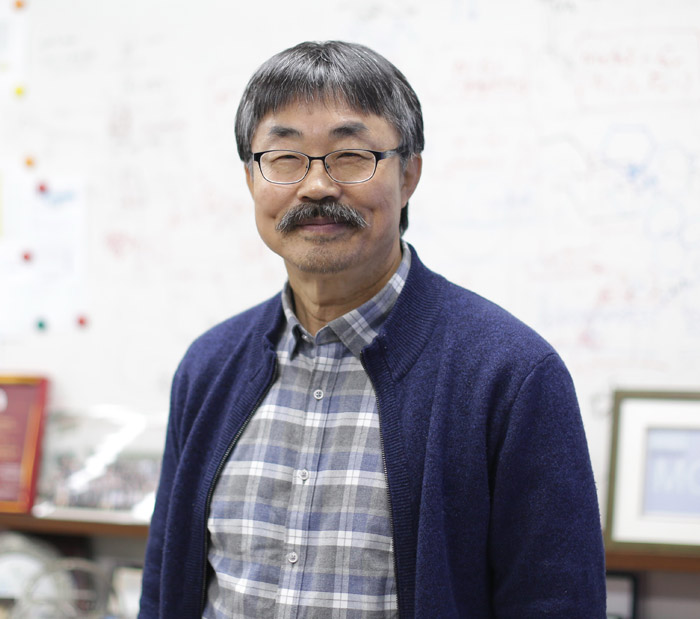Research Stories
Solution to the heterologous synthesis of “Two-Dimensional Matter”
Error-free heterologous synthetic matter expected to be the core element of electronic device in the future
Physics
Prof.
LEE, YOUNGHEE
Prof. Younghee LEE (Dept. of Energy Science) has developed a technology to synthesize Hexagonal boron nitride, a Two-Dimensional matter composed of two elements (nitrogen and boron) into a single crystal through a joint research.
*Hexagonal boron nitride; hBN: a flat layered material composed of boron and nitrogen with an atomic structure of a hexagon (like graphene)
The result of the research has been published in the world-renowned international journal Science (issue date: November 16th).
*Title of the thesis: Wafer-scale single-crystal hexagonal boron nitride film via self-collimated grain formation
*Lead author: Researcher Joosong LEE(KIST, 1st author), Dr. Soomin KIM (KIST, Corresponding author), Head Younghee LEE (IBS, Corresponding author), Prof. Kigang KIM (Univ. of Dongguk, Corresponding author)
Two-dimensional matters are excellent in the electrical feature, flexibility and transparency and is recognized as the core element of future electronic devices. It blocks the penetration of gas, which makes it suitable to be used for the protection of the elements. Boron nitride is receiving attention for its use as an insulation shield of transparent flexible electronic devices because it is the only two-dimensional matter that has the feature of insulation.
However, the problem remains as they need to solve the issue of synthesizing it into a single crystal in order to keep the feature of boron nitride. The large-scaled boron nitride from the previous synthesis method was synthesized into a form of polycrystal, which showed deficiency in insulation and atomic linkage.
Single Crystal: the state of crystals gathered in a specific order
Polycrystal: many crystals are gathered in an irregular form. The linkage between crystals are imperfect
The research team was able to synthesize a thin-film of single crystal boron nitride by using the phenomenon of self-collimation on the surface of liquid gold. This method enables the synthesis of single crystal regardless of the size of thin-film.
*Self-Collimation: when the crystal grain of boron nitride is formed on the surface of the liquid gold, nitrogen and boron atoms cause an electrical gravitational pull to push and pull one another to keep an optimal distance.
Also the team was able to synthesize other two-dimensional matters such as graphene, WS2, MoS2 into a single crystal by using the thin-film. They were also successful in synthesizing graphene and boron nitride into a form of layered structure.
*Graphene: one of allotropes of carbon. The carbon atoms are formed in a shape of hexagon with a thin layer and shows high physical and chemical stability.
The research is evaluated to have opened a new paradigm by developing an original technology to synthesize two-dimensional matter into a large-scaled single crystal. It is expected to bring innovation in the development of future transparent flexible electronic devices, gas barrier, sensors and filters.
This research was conducted with the support of the Ministry of Science and ICT, Institute for Basic Science and the KIST (Korea Institute of Science and Technology).
[Figure 1]
A mimetic diagram of large-scaled single crystal synthesis due to self-collimation and two-dimensional boron nitride crystal grain
[Figure 2]
The synthesis of two-dimensional matters with the use of large-scaled single crystal boron nitride. Observed that it is arrange in a single direction.
[Figure 3]
Effective in improving the penetration of moisture in air and oxidation of metal despite the 0.3nm of thin-film.


